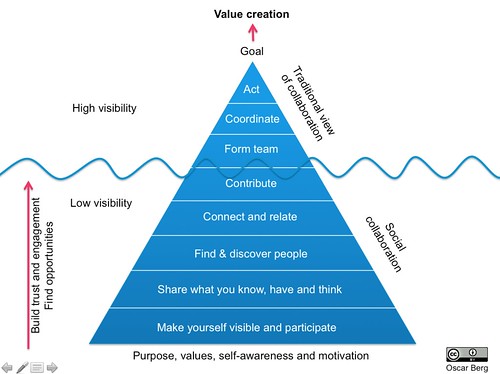The Collaboration Pyramid offers a great visual to explain how an edcamp unconference can be such a powerful collaborative professional development and learning tool.
In traditional team-based collaborative models we experience the "form, storm, norm and perform" process, and it has proved to be very useful in the context of team effectiveness, but perhaps leaves a bit of a void in the area of personal responsibility, or individual motivation to make a meaningful contribution to the team.
The Collaboration Pyramid displays a broader platform to support a different context for collaboration that may eventually lead to more authentic and meaningful personal investment in the team process. I think social collaboration as framed in the diagram is closely related to the concept of morphic resonance.
morphic resonance [ˈmɔːfɪk]
n
(Life Sciences; Allied Applications / Biology) the idea that, through a telepathic effect or sympathetic vibration, an event or act can lead to similar events or acts in the future or an idea conceived in one mind can then arise in another...In the first stage of social collaboration it is assumed that individuals have reflectively defined their own purpose and values, and that through reflection, these have manifested as personal philosophies; relative degrees of self-awareness and motivation to be present and contribute. This is the point where individuals become participants; they become visible as "receivers." Our personal philosophies become known and ideas conceived in our minds can then arise in another by way of social interaction.
This act of becoming visible and participating as a receiver creates possibility in learning and sharing. It's where morphic resonance begins. It is the first stage of interaction in the social collaboration process. Putting ourselves out there as receivers in the collaborative process frames our participation in group learning as self-motivated, reflective and social. It puts us in motion toward others who are also self-motivated, reflective and social, and the interdependent levels of the collaboration pyramid begin to flourish.
When we share what we know, have and think, we are displaying vulnerability in the learning process. Sharing is a fundamental element of social participation that feeds into the self-organized environment that is an edcamp unconference. When we are vulnerable and put our knowledge and thoughts out there, we tend to attract others who are compelled by similar domains of knowledge and ideas. When we begin to talk about these shared domains, the dialogue may attract new collaborators intrigued by a perspective they hadn't considered yet. People find others and discover their varied points of view, and they choose to connect and relate, or not... and the or not part of this is very important. The foundation of purpose, values, self- awareness and motivation that underpins everyone's relative participation in the collaboration pyramid helps them decide whether to engage, or not. It is more than OK for people to not engage. Choice is the rule of engagement. Everyone at an edcamp has the right to choose whether to engage in sharing and receiving, or not depending on their independent purpose, values, self-awareness and motivation.
The social collaboration side of the Collaboration Pyramid posits a collaborative model where the processes of building trust, engaging with others and their ideas and seeking learning opportunities becomes more ubiquitous, open and visible. The social side of the Collaboration Pyramid is, I think, what makes edcamp unconferences so intriguing to people. Edcamps provide opportunities for people to create value through their choices to share what they know and think, and also to receive what others know and think through social participation. As the day of our edcamp unfolds, we anticipate countless opportunities will emerge as participants interact on various levels of the Collaboration Pyramid, and we wouldn't be surprised at all if connections are made that lead to really invested teams of people forming, storming, norming and performing toward goals that lead to value creation in the future.
So far this May 11 in Red Der, AB, participants will be able to choose whether they want to participate in these proposed sessions at Redcamp 2013...
- Resilient teaching and learning
- Creative teaching and learning
- Google EDU teaching and learning environments
- Blogging in teaching and learning
- The power of social networking in education
- Empathetic teaching and learning
- Technology in the elementary classroom
- Technology and Language Arts
- Activity in the classroom
- Curriculum integration
- Building leadership capacity
- Effective middle schools
- Middle school philosophy
- Elementary PE
- Using drama in core subjects
- Introduction to Google Apps for Education
- iPads in the classroom
- Wikis in the classroom
- Making music and concerts a ubiquitous element to enhance curriculum and school culture
- Creating a safe environment for LGBTQ students
- Drumming and rhythm in the classroom
- Curriculum integration (resources)
- Twitter, Creativity, Helping Struggling students
- Assistive technology
- Inclusion
- Literacy
- Reading College - YIMBY Reads
- Assessment is not a spreadsheet - it's a conversation
- Homework is something to be inspired - not assigned
- Students should experience their successes and failures not as reward and punishment but as information
- Prezi for beginners
- Progressive Education Conversation in Alberta
- Behavior Education
- Relational aggression in girls
- Curriculum Integration
- Project based learning for the 21st century learner
- Inquiry learning for the 21st century learner
- 21st Learning Competencies in the Classroom
- Assessment without grades or traditional exams
- Creativity- the key to unlocking possibilities
- Storytelling
- Creative math
Hope to see you at #redcamp13! Register by clicking the red EventBrite button at the top right side of this site.



No comments:
Post a Comment